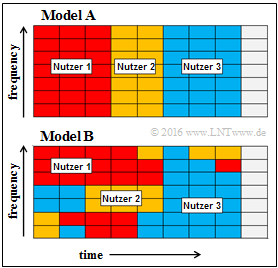Difference between revisions of "Aufgaben:Exercise 4.3Z: Multiple-Access Methods in LTE"
| Line 18: | Line 18: | ||
''Notes:'' | ''Notes:'' | ||
*The task belongs to the chapter [[Mobile_Communications/The_Application_of_OFDMA_and_SC-FDMA_in_LTE|The Application of OFDMA and SC-FDMA in LTE]]. | *The task belongs to the chapter [[Mobile_Communications/The_Application_of_OFDMA_and_SC-FDMA_in_LTE|The Application of OFDMA and SC-FDMA in LTE]]. | ||
| − | *All necessary information can be found on the page [[Mobile_Communications/The_Application_of_OFDMA_and_SC-FDMA_in_LTE#Similarities_and_differences_of_OFDM_and_OFDMA|Similarities and differences of OFDM and OFDMA]] as well as in the chapter [[Modulation_Methods/Aufgaben_und_Klassifizierung| | + | *All necessary information can be found on the page [[Mobile_Communications/The_Application_of_OFDMA_and_SC-FDMA_in_LTE#Similarities_and_differences_of_OFDM_and_OFDMA|Similarities and differences of OFDM and OFDMA]] as well as in the chapter [[Modulation_Methods/Aufgaben_und_Klassifizierung|Multiple Access Methods]] in the book "Modulation Methods". |
Revision as of 16:15, 2 February 2021
In the case of the 4G mobile radio system LTE, there was a change not only in the type of modulation compared with the 3G system UMTS , but also in the access procedure in particular. A suitable access method is characterized by the fact that as many users of a radio cell as possible can be supplied with the highest possible data rate. The total throughput is decisive.
The figure shows two diagrams $\rm A$ and $\rm B$ with exemplary frequency-time assignments. You should decide which access methods should be explained by these two diagrams.
Notes:
- The task belongs to the chapter The Application of OFDMA and SC-FDMA in LTE.
- All necessary information can be found on the page Similarities and differences of OFDM and OFDMA as well as in the chapter Multiple Access Methods in the book "Modulation Methods".
Questionnaire
Solution
(1) Correct are the solutions 3 and 4. LTE uses
- Orthogonal Frequency Division Multiple Access (OFDMA) in downlink,
- Single Carrier Frequency Division Multiple Access (SC–FDMA) in uplink.
- Code Division Multiple Access is used in the 3G mobile system UMTS eingesetzt.
- Bei DSL verwendet man Orthogonal Frequency Division Multiple Access.
- Dieses ist aber in diesem Zusammenhang eher als Modulationsverfahren zu verstehen, nicht als Vielfachzugriffsverfahren.
(2) Correct are the answers 2 and 4:
- Several users can occupy one frequency block.
- TDMA is additionally possible.
- The suggestion 1 corresponds to CDMA, suggestion 3 applies to OFDM.
(3) According to the sample solution to the task (2) the second proposal is applicable ⇒ diagram $\rm B$.
(4) Correct are the solution proposals 1 and 2 in contrast to proposal 3:
- Since OFDMA resource allocation is not only limited to the time domain, but also optimally includes the frequency domain, OFDMA is more flexible than OFDM. Of course, the users with the best boundary conditions for resource allocation are preferred.
- The rather unsolidary principle "If you're already doing well, you'll be given" is therefore applied. This is often found in politics as well.
- It is undisputed, however, that in this way the total throughput of the cell is maximised, which is the basis for optimisation for the network operators.
- If the entire power were to be made available to a user with extremely poor conditions, the total throughput would be close to zero.
